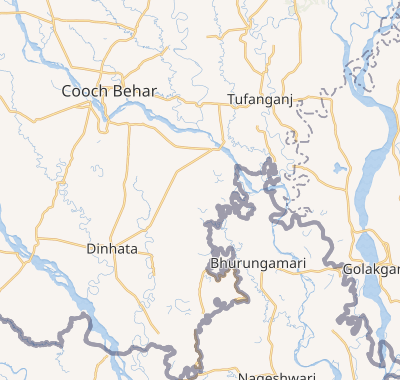Chamta
Chamta | |
|---|---|
Village | |
| Coordinates: 26°18′27″N 89°39′14″E / 26.3075°N 89.6539°E | |
| Country | |
| State | West Bengal |
| District | Cooch Behar |
| Population (2011) | |
| • Total | 8,190 |
| Time zone | UTC+5:30 (IST) |
| PIN | 736159 |
| Telephone/STD code | 03582 |
| Vehicle registration | WB |
| Lok Sabha constituency | Alipurduars |
| Vidhan Sabha constituency | Tufanganj |
| Website | coochbehar |
Chamta is a village in the Tufanganj I CD block in the Tufanganj subdivision of the Cooch Behar district in West Bengal, India
Geography
[edit]
5miles
temple
Pratham
Khanda
CT: census town, M: municipal town, R: rural/ urban centre, H: historical/ religious centre
Owing to space constraints in the small map, the actual locations in a larger map may vary slightly
Location
[edit]Chamta is located at 26°18′27″N 89°39′14″E / 26.3075°N 89.65399°E.
Area overview
[edit]The map alongside shows the eastern part of the district. In Tufanganj subdivision 6.97% of the population lives in the urban areas and 93.02% lives in the rural areas. In Dinhata subdivision 5.98% of the population lives in the urban areas and 94.02% lives in the urban areas.[1] The entire district forms the flat alluvial flood plains of mighty rivers.[2]
Note: The map alongside presents some of the notable locations in the subdivisions. All places marked in the map are linked in the larger full screen map.
Demographics
[edit]As per the 2011 Census of India, Chamta had a total population of 8,190. There were 4,240 (52%) males and 3,950 (48%) females. There were 885 persons in the age range of 0 to 6 years. The total number of literate people in Chamta was 5,529 (75.69% of the population over 6 years).[3]
Culture
[edit]There is a small temple with char-chala tin roof, wherein a triangular stone covered with vermillion is worshipped as Devi Ghurneswari, a form of goddess Kali. A trishula representing Bhairava is also worshipped. The temple draws devotees in large numbers on festive occasions. According to local legend, a cow/ buffalo used to come regularly and offer milk to the stone-piece lying under a banyan tree. Information about the incident reached Maharaja Harendra Narayan (1780-1839) of Cooch Behar State. He had a temple built, but the present one seems to be a later construction.[4]
References
[edit]- ^ "District Statistical Handbook 2013 Cooch Behar". Tables 2.2, 2.4b. Department of Planning and Statistics, Government of West Bengal. Archived from the original on 21 January 2019. Retrieved 5 August 2020.
- ^ "District Census Handbook, Koch Bihar, Series 20, Part XIIA" (PDF). Census of India 2011, pages 17-21 Physical feafures. Directorate of Census Operations, West Bengal. Retrieved 5 August 2020.
- ^ "C.D. Block Wise Primary Abstract Data(PCA)". West Bengal – District-wise CD Blocks. Registrar General and Census Commissioner, India. Retrieved 3 August 2020.
- ^ Koch Bihar Jelar Purakirti (in Bengali), Data compilation and writing by Dr. Shyamachand Mukhopadhayay, published by the Department of Archaeology, Government of West Bengal, Second edition 1974, Pages 47-48.


